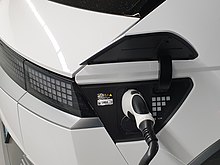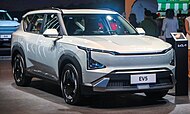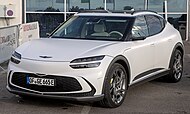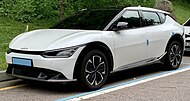Hyundai Electric Global Modular Platform
| Electric Global Modular Platform (E-GMP) | |
|---|---|
Dual-motor, all-wheel-drive |
Hyundai E-GMP (Electric Global Modular Platform) is a dedicated
It follows Hyundai's earlier Power Electric System (PE System), which describes the drivetrain of an electric vehicle, including the traction motor, storage battery, and power electronics.History
The PE System serves the same function for an electric vehicle as an
In 2017, Hyundai confirmed reports that it was developing a dedicated platform for electric vehicles; at the time, only a few manufacturers had done so.
The PE System has also been installed into the Hyundai Vision FK concept, an eco-friendly hydrogen electric vehicle. In this vehicle, the PE System has been combined with a hydrogen fuel cell system.[6]
A standardized battery system can be tuned and implemented as part of the system appropriate for a specific vehicle segment. This system is said to maximize driving range or meet the needs of a customer.[7]
Technical design
The E-GMP platform is an 800 V architecture with scalable wheelbase length, and supports batteries from multiple manufacturers. The motor, inverter, and transmission are integrated into a single powertrain unit.[8]
Traction motor
Both single motor 2WD (rear axle) and dual motor AWD are supported.[9] Hyundai claim the motor is approximately 10% more efficient than a conventional motor due to "hairpin winding technology", allowing the coils to be wound more densely, and more effective cooling.[10]
Reduction gear transmission
The transmission reduces the traction motor speed and applies torque to the driven axle. This effectively multiplies torque at the wheel for electric vehicles. In addition, an EV Transmission Disconnector is provided, which allows for the motor and drive axle to be disconnected, which enables free shifting between 2WD (two-wheel drive) and 4WD (four-wheel drive). This is only available for the all-wheel drive system.
Battery and charging

The
Current (as of 2022) DC fast charging infrastructure has a power and voltage of 50–350 kW and 400-920 V.[10] The E-GMP electronics support voltages of both 400 V and 800 V charging systems and offers bi-directional charging (V2L (110/230 V and up to 3.7 kW),[13] V2V and V2G).[11] The platform uses the vehicle's motor/inverter to convert incoming DC current at 400 V to 800 V.[8]
Inverter
The inverter converts
Chassis
The platform supports a wheelbase exceeding 3,000 mm (118.1 in).
The battery is attached to the full-perimeter frame using eight bolts running completely through the battery for strength. The front and rear crumple zones are designed to absorb and dissipate the energy of a potential impact, and high strength steel is used to protect the battery and passenger compartment.[10]
Applications
Hyundai plan to release 23 battery electric vehicles, including 11 exclusively electric vehicles, using the E-GMP platform.[12]
- Models released
- Genesis GV60 (JW) (2021–present)
- Hyundai Ioniq 5 (NE) (2021–present)
- Kia EV6 (CV) (2021–present)
- Hyundai Ioniq 6 (CE) (2022–present)
- Kia EV9 (MV) (2023–present)
- Kia EV5 (OV) (2023–present)
-
Genesis GV60
-
Hyundai Ioniq 5
-
Hyundai Ioniq 6
-
 Kia EV5
Kia EV5 -
Kia EV6
-
Kia EV9
- Upcoming models
See also
- Volkswagen Group MEB platform – a similar multi-vehicle electric platform
References
- ^ "Hyundai Motor Group reveals E-GMP; first dedicated BEV platform, for next-generation BEV line-up". Green Car Congress. BioAge Group, LLC. 2020-12-02. Retrieved 3 December 2020.
- ^ "Interview with Researchers The Story of EV Technology on E-GMP". tech.hyundaimotorgroup.com. March 30, 2021.
- ^ Jin, Hyunjoo (August 16, 2017). "Hyundai plans long-range premium electric car in strategic shift". Reuters. Retrieved 22 December 2021.
- ^ Voelcker, John (August 17, 2017). "Hyundai-Kia: eight electric cars by 2022, dedicated EV platform". Green Car Reports. Retrieved 22 December 2021.
- ^ "Electric Vehicle The Crux of Mobility's Sustainable Future". tech.hyundaimotorgroup.com. March 14, 2021.
- ^ "Vision FK, the world's high-performance eco-friendly hydrogen electric vehicle". tech.hyundaimotorgroup.com. September 7, 2021.
- ^ "Hyundai Motor Group to Lead Charge into Electric Era with Dedicated EV Platform 'E-GMP'". HYUNDAI MOTORS. Retrieved 2022-03-31.
- ^ a b c d Choi Woo Suk (January 4, 2021). "Looking into E-GMP: A Balance of Function and Sensibility" (Interview). Hyundai Motor Group. Retrieved 13 December 2021.
- ^ a b Chaouite, Jalil (2020-12-02). "Voitures électriques : la nouvelle plateforme Hyundai et Kia promet plus de 500 km d'autonomie". L’Automobile Magazine (in French). Retrieved 3 December 2020.
- ^ a b c d e f "전기차 전용 플랫폼 E-GMP의 5가지 핵심 장점" [5 key benefits of the E-GMP electric vehicle platform] (in Korean). Hyundai Motor Group. December 2, 2020. Retrieved 13 December 2021.
- ^ a b Hampel, Carrie (2020-12-02). "Hyundai presents E-GMP electric car platform". electrive.com. Retrieved 3 December 2020.
- ^ a b c Hugo Quintal (2 December 2020). "Hyundai to lead charge into electric era with EV platform 'E-GMP'".
- ^ Baldwin, Roberto (December 2, 2020). "Hyundai Unveils EV Platform, Will Have 23 Global Electric Vehicles by 2025". Car and Driver. Retrieved 13 December 2021.
- ^ Lovati, Stefano (March 17, 2021). "10 Things to Know About SiC". www.powerelectronicsnews.com.
- ^ Dnistran, Iulian (December 9, 2022). "Hyundai's E-GMP EVs To Get Better Range And Improved Performance". Inside EVs. Retrieved 9 January 2023.
- ^ a b "Executive Interviews on E-GMP". Hyundai Motor Group. December 16, 2020. Retrieved 13 December 2021.
- ^ "현대차그룹의 글로벌 전기차 전용 플랫폼 E-GMP에 관해 묻다" [Answers about Hyundai Motor Group's global EV-only platform E-GMP] (in Korean). Hyundai Motor Group. December 11, 2020. Retrieved 13 December 2021.
- ^ Blanco, Sebastian (December 2, 2020). "Hyundai Rolls Out Skateboard-Like EV Platform". Wards Auto.
It's just too good to give up on [our current lineup of ICE-platform-based electric vehicles such as the Kia Niro EV, Hyundai Kona EV and Ioniq EV], so we will continue with derivative EVs based on our next-generation front-wheel-drive platform and of course they will become even more efficient with better performance. We will follow both ways.
- ^ Carson, Sean (21 August 2021). "New Kia EV4 on course to grow electric SUV range". AutoExpress. Retrieved 21 December 2021.
- ^ Hoffman, Connor (November 11, 2021). "Kia EV9, Hyundai Ioniq 7 Will Be Like Electric Telluride, Palisade". Car and Driver. Retrieved 21 December 2021.
- ^ Miller, Caleb (November 17, 2021). "Hyundai Seven Concept Previews Electric SUV For Ioniq Sub-Brand". Car and Driver. Retrieved 21 December 2021.
- ^ "Hyundai rumored to rename the upcoming Ioniq 7 to Ioniq 9". ArenaEV.com. Retrieved 2024-03-07.






